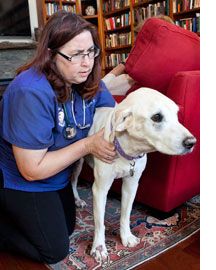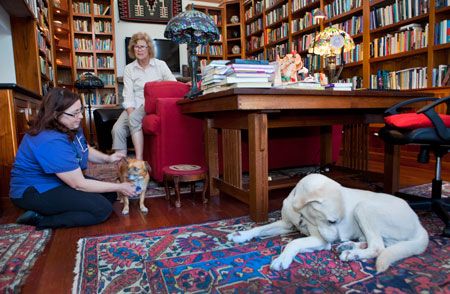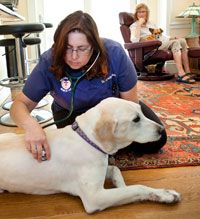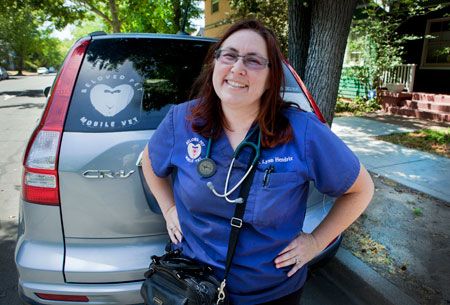Learning goodbye: Veterinarians fill a void by focusing on end of life care
Veterinarians dedicating their careers to hospice and euthansia medicine may be pioneering the profession's next specialty-at clients' request.
Veterinarians dedicating their careers to hospice and euthansia medicine may be pioneering the profession's next specialty-at clients' request.

Photos by Steve Yeater
It’s what every veterinarian hears while preparing a family for the euthanasia process: “This must be so hard.” For someone like Dr. Lynn Hendrix, who practices house call hospice and euthanasia with Beloved Pet Mobile Vet in Davis, Calif., it’s a daily topic of conversation. “I struggle with the answer, because I find it rewarding,” Hendrix says. “Not the euthanasia, but the interaction with people.”
Hendrix is one of a growing number of veterinarians seeking to change the way the veterinary profession deals with end-of-life care for pets. Working as a registered veterinary technician prior to veterinary school, Hendrix already saw the appeal of strong nursing care, but it was her own mother’s terminal illness that set the stage for her career. “My mom was in hospice. It changed who I was and my path in life,” Hendrix says. “I feel like it was a gift from her to put me on this path. I thought, why are we doing end of life care for pets like we do?”
Hendrix practiced emergency medicine for nine years after graduation before opening her house call practice. She quickly learned that while in-home euthanasia was a commonly requested service, very few clients or veterinarians had any idea what hospice care entailed. “We’re taught to be curative doctors,” Hendrix says. “We’re not taught anything about end-of-life. Here’s the disease process and here’s how to cure it, or euthanize.”

If a client and a veterinarian are on the same page about quality of life issues and when euthanasia is the correct choice, there’s not a problem. But oftentimes clients are reluctant to euthanize a pet and instead ask for palliative care, and Hendrix feels this gray area is where veterinarians really need to improve. “Many veterinarians don’t see natural deaths very often. We’re not taught about chronic pain.
“I see it over and over again,” Hendrix says. “A client’s veterinarian tells them they are going to do hospice and sends them home with 50 mg of tramadol twice a day for a 150-pound dog. It doesn’t work, so they stop giving it.” When they call Hendrix, many are unaware that other options exist beyond choosing to euthanize right away. “Nobody explains to them this is what you need to do, and this is how things are going to go.”

For Hendrix, it’s all about client education and making a plan. To that end, she was one of a team of end-of-life experts who drafted the Guidelines for Recommended Practices in Animal Hospice and Palliative Care. The guidelines, published by the International Association for Animal Hospice and Palliative Care (IAAHPC), are an attempt to standardize best practices in a rapidly evolving segment of the field. “Hospice was not recognized by the human medical field at all for years,” Hendrix says. “They were considered quacks. Now it’s a recognized specialty.”
Dr. Kathleen Cooney, who practices in Loveland, Colo., with Home to Heaven, is another advocate for improved client education regarding end-of-life care. When she opened her house call practice in 2006, it was strictly a euthanasia service. After three years, she expanded her service to incorporate hospice care as well. “When I was going in there to help families, the families were so relieved when death came,” Cooney says. “It’s almost as if the human animal bond was breaking down—they’re desperate for the death.” She found herself asking, “Where is the fear coming from? How was it allowed to get this bad?”
Cooney finds that many clients approach her after being frustrated by their experience at their regular veterinarian. “My clients around here share with me that they are not getting the support they need from their veterinarians and [the veterinarians are] not really listening to what the family is saying,” she says. “The veterinarians are so focused on life that when a terminal diagnosis is given they aren’t doing the education that they should—setting a plan for what to expect, determining who are the caretakers. The veterinarians just aren’t programmed to talk about death, palliative care or end-of-life.”


Cooney considers hospice consultation a major opportunity for veterinarians to retain their clients and improve their service. “They don’t have to let that out their door. They should be hanging on to every opportunity possible to maintain that business from womb to tomb. They can still start the process and help that family make a decision about where to go from there. They have such an opportunity.”
She is hopeful that veterinarians are receptive to the ideas she is promoting. “I think over the last five years it’s been changing. Those of us in this service are making vets more aware of the possibilities.”
One of the biggest hurdles in animal hospice is looking beyond pain management and incorporating a hospice team to address the many other elements of end-of-life care. Many of these focus not on the pet, but on the caregiver. For Hendrix, addressing mental health considerations for clients is a paramount concern.
She relates the story of one client who seemed to be struggling with grief over the loss of his dog, but insisted to family members that he was fine. “Within the month, I read that he’s dead, and the way that it sounded was that he committed suicide, and the inciting factor was the death of his dog,” she says. Whether or not that was the case, Hendrix was deeply affected.
“We’re not trained to care for the mental health of our clients,” she says. “We’re trained to take care of the animals. But I absolutely think veterinarians have an obligation to have a mental health professional available for our clients.”
Bonnie Mader agrees. As the developer of the pioneering Pet Loss Support Hotline at the University of California-Davis, Mader used her training as a mental health professional to teach veterinary students about the toll pet loss and grief can take on an owner. “It’s not only an ethical issue, it’s a humanitarian one,” Mader says. “We have to raise the awareness to veterinarians and families both about the benefits of mental health care.”
Mader points to human hospice as a model for animal hospice practitioners. “On an accredited [human] hospice team, you have mental health professionals,” she says. Both Mader and Hendrix agree that referring to a qualified professional when needed is a key part of managing the client’s mental health needs. Part of that responsibility entails recognizing instances where a referral is likely needed, which is covered in the IAAHPC guidelines.
Hendrix hopes that one day hospice care is a recognized specialty in veterinary medicine. Until then, she’s happy to encourage veterinarians to familiarize themselves with the task-force guidelines, even if they do not regularly offer hospice care. “One of the things I can tell you about the history of animal hospice is that it started as an alternative thing; the mainstream veterinary population looked at it like we were quacks,” she says. “It’s getting better.”
Shortly after the death of her client, Hendrix was called to another case that left her concerned for the owner. “She had been abused in the past,” Hendrix related, “and she informed me that the cat I was about to euthanize was her touchstone. This was the cat she got to help her during therapy.”
Hendrix spoke with her and, using the skills she had learned in hospice training, was able to ask the right questions to make sure the client was not in a crisis situation. “I made sure she had available people.” Hendrix pauses. “She’s doing well.”
For more information about the IAAHPC Task Force Guidelines, visit iaahpc.org.
Dr. Jessica Vogelsang, known as Dr. V. among her readers, is a regular contributing author for a number of well-known publications. Visit her award-winning blog at pawcurious.com.

Podcast CE: A Surgeon’s Perspective on Current Trends for the Management of Osteoarthritis, Part 1
May 17th 2024David L. Dycus, DVM, MS, CCRP, DACVS joins Adam Christman, DVM, MBA, to discuss a proactive approach to the diagnosis of osteoarthritis and the best tools for general practice.
Listen